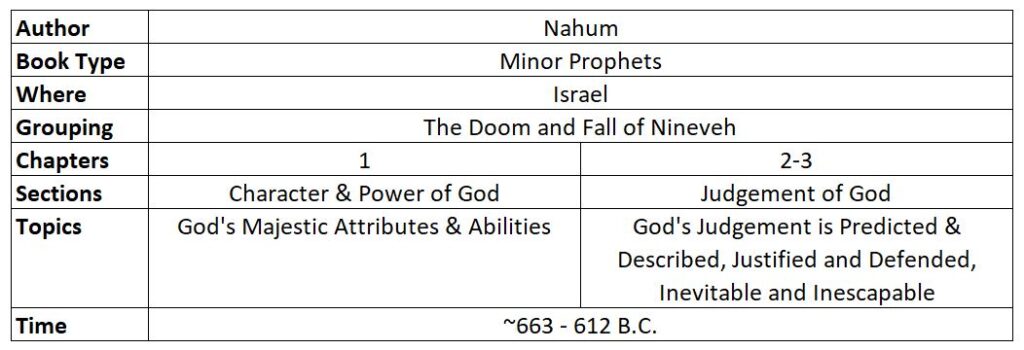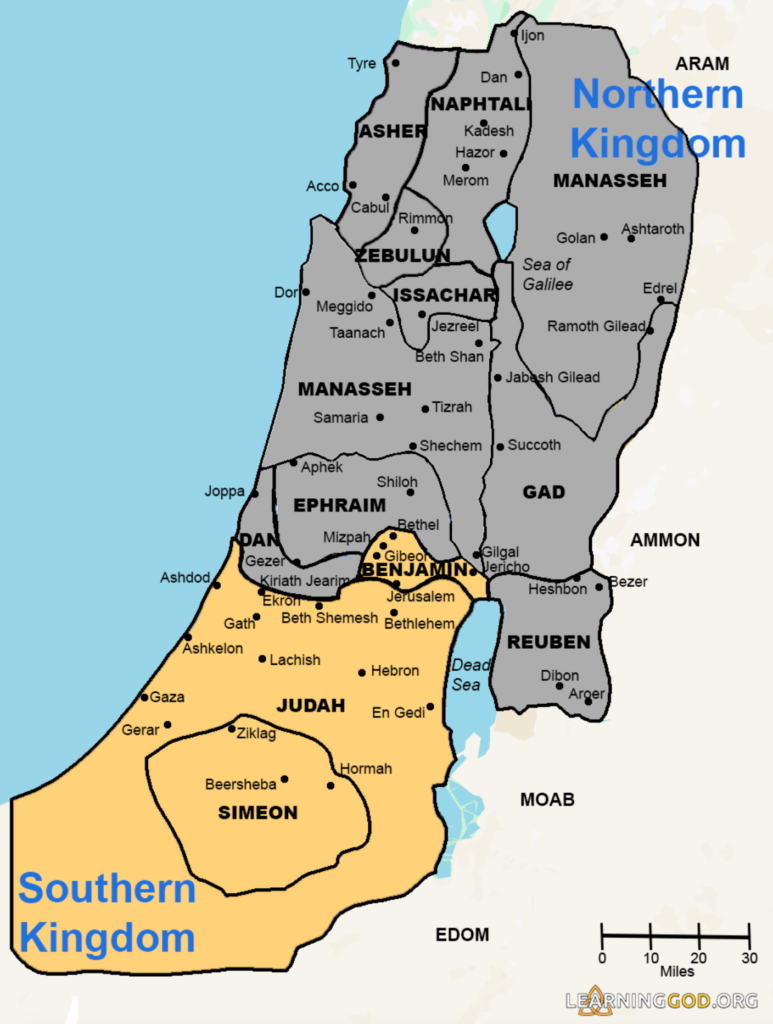Nahum
The Doom & Fall of Nineveh
Summary | About | Why You Should Read it | Author | When Written | Context | Timeline | Location | Outline | Observations | Resources
Summary
The Book of Nahum is a short prophetic text in the Old Testament, consisting of three chapters. It is attributed to the prophet Nahum and primarily focuses on the impending destruction of Nineveh, the capital of the Assyrian Empire.
Key Themes:
- God’s Justice: Nahum emphasizes that God is a righteous judge who will punish wickedness. The book foretells the downfall of Nineveh as divine retribution for its violence, oppression, and idolatry.
- The Fall of Nineveh: The prophecy centers on the fall of the powerful Assyrian city. Nahum vividly describes the city’s destruction, offering hope to those oppressed by Assyrian rule, particularly the people of Judah.
- God’s Power and Sovereignty: Throughout the book, Nahum highlights God’s control over nations and history. The Assyrians, who once seemed invincible, will be humbled by God’s hand.
Tone:
Nahum is filled with vivid, poetic descriptions of destruction and chaos, but it also reflects comfort for those who have been oppressed, assuring them that God will avenge injustice.
While the book is focused on judgment against Nineveh, it also carries a broader message about God’s commitment to justice and his defense of the faithful.
The following table provides a high-level look at the structure and contents of the book of Nahum.

About
Nahum is the 34th book of the Bible and the seventh of the books of the Minor Prophets in the Old Testament.

Why You Should Read It
You might read the Book of Nahum for several important reasons, as it offers lessons and insights that remain relevant today:
- Understanding God’s Justice and Sovereignty:
Nahum emphasizes that God is not indifferent to evil. His judgment against Nineveh reflects His unwavering commitment to justice and His control over the rise and fall of nations. For Christians, this reinforces the belief that God’s justice will ultimately prevail over injustice in the world, even when it seems delayed.
- Hope in the Face of Oppression:
The book was a message of hope to the people of Judah, who had suffered under Assyrian oppression. In the same way, Christians can find comfort in Nahum’s message that God sees injustice and will act in His time to correct wrongs. It reminds believers that God is with the oppressed and will bring about deliverance.
- The Nature of God’s Character:
Nahum presents a balanced view of God’s character—both His wrath against sin and His goodness towards those who trust in Him. This duality helps Christians understand that God’s love does not negate His justice, and His patience does not imply a tolerance of evil. Nahum’s portrayal of God can deepen a Christian’s understanding of His holiness and righteousness.
- Warnings Against Pride and Arrogance:
The fall of Nineveh serves as a warning against pride, self-reliance, and wickedness. For Christians, this serves as a reminder that no individual, city, or nation is beyond God’s reach or judgment. It calls believers to live humbly before God, recognizing that all power and success ultimately come from Him.
- Encouragement to Trust in God’s Timing:
Nahum reminds believers that God’s timing is not always aligned with human expectations, but He is always at work behind the scenes. This encourages Christians to remain patient and trust in God’s plans, even when circumstances seem grim.
- A Picture of Christ’s Future Victory:
For Christians, Nahum can be read in the larger biblical context, where God’s judgment against evil is seen as a precursor to the ultimate defeat of sin and evil through Jesus Christ. Nahum’s prophecy reflects God’s ultimate victory over all forms of evil, a theme that points forward to Christ’s second coming.
In summary, the Book of Nahum encourages us to trust in God’s justice, rest in His sovereignty, and be assured that evil will not triumph in the end. It calls believers to live in the light of God’s righteousness and to trust that He will bring about justice in His time.
Author
The author of the Book of Nahum is the prophet Nahum, though very little is known about his personal life or background. The name “Nahum” means “comfort” or “consolation,” which is fitting given the book’s message of comfort to the people of Judah, who were oppressed by the Assyrians. His prophecy was a message of comfort for Judah and a declaration of judgment for Nineveh.
Nahum is described as “Nahum of Elkosh” (Nahum 1:1), but the exact location of Elkosh is debated.
When Written
Nahum’s prophetic ministry likely took place sometime between 663 B.C. (the fall of Thebes, referenced in Nahum 3:8) and 612 B.C. (the fall of Nineveh). This would place him in the latter part of the 7th century B.C., during a time when Assyria was still a dominant force but beginning to show signs of decline.
Context
The Book of Nahum was written in the context of the Assyrian Empire’s dominance in the ancient Near East, particularly its oppressive reign over Israel and Judah. Here are the key historical and political factors that frame the context of Nahum:
- Assyrian Empire’s Power:
During Nahum’s time, the Assyrian Empire was the most powerful empire in the world. It had already destroyed the Northern Kingdom of Israel in 722 B.C. and had exerted significant control over the Southern Kingdom of Judah. The Assyrians were known for their brutal military campaigns and oppressive tactics, including mass deportations and harsh treatment of conquered peoples.
Nineveh, the capital of Assyria, was a symbol of the empire’s power, wealth, and cruelty. The Assyrians had terrorized much of the ancient world, including Judah, which often lived in fear of their invasions and demands for tribute.
- Judah’s Oppression and Hope:
Judah had experienced immense suffering under Assyrian domination. King Hezekiah, for instance, had been forced to pay heavy tribute to Assyria, and the threat of destruction loomed over Judah for decades. The prophet Nahum, however, prophesied the fall of Nineveh and the end of Assyria’s dominance. This message was likely delivered during a period when Judah was desperate for relief from the empire’s oppression.
Nahum’s prophecy would have offered comfort to the people of Judah, who were weary of Assyrian tyranny. It assured them that God had not forgotten their suffering and that He would soon bring judgment upon Nineveh, the source of their oppression.
- The Imminent Fall of Nineveh:
Historically, Nahum’s prophecy was written sometime between 663 B.C. (the fall of Thebes, which is referenced in Nahum 3:8) and 612 B.C., when Nineveh was destroyed by a coalition of the Babylonians, Medes, and Scythians. By the time Nahum prophesied, Assyria’s power had begun to wane, although it was still formidable.
The prophecy of Nahum predicted the fall of Nineveh, which seemed impossible at the time, given Assyria’s military might. Yet within a few decades, Nahum’s prophecy was fulfilled when Nineveh was utterly destroyed, marking the end of the Assyrian Empire.
- Theological Message:
Theologically, Nahum was written to demonstrate that God is sovereign over all nations and holds them accountable for their actions. Assyria’s cruelty, idolatry, and arrogance had reached a point where God’s judgment was inevitable. Nahum’s prophecy served as a reminder to both Judah and the surrounding nations that God is a just and powerful ruler who brings down oppressive regimes in His time.
For Judah, Nahum’s message was both a warning and a comfort—warning them against following in the sinful ways of Assyria and comforting them with the assurance that their oppressors would be judged by God.
- Prophetic Tradition:
Nahum’s prophecy fits within the broader tradition of Old Testament prophets who spoke out against foreign nations and predicted their downfall as part of God’s justice. Nahum’s focus on Nineveh and Assyria specifically builds on the earlier prophetic messages found in books like Jonah, which also addresses Nineveh, though from a different angle (calling for repentance rather than prophesying destruction).
The Book of Nahum was written during a time when the Assyrian Empire dominated the ancient world, particularly oppressing Judah. It was a message of hope to the people of Judah, assuring them that God would soon destroy their powerful and oppressive enemy, Nineveh, and that justice would be served. The fall of Nineveh, prophesied by Nahum, came to pass within a few decades, highlighting the power of God over the nations and His care for the oppressed.
Timeline
The timeline below shows from the beginning of the monarchy with Saul through the start of the Exile. Nahum takes place In the mid to early 600s B.C. before the fall of Jerusalem to Babylon.
Location
Nahum was an Israelite from Elkosh (unknown location). He likely wrote his work in Israel and it was addressed to the Israelites.
Outline
| I. Title (1:1) |
| II. Nineveh’s Judge (1:2-15) |
| A. The Lord’s Kindness and Sternness (1:2-8) |
| B. Nineveh’s Overthrow and Judah’s Joy (1:9-15) |
| III. Nineveh’s Judgment (ch. 2) |
| A. Nineveh Besieged (2:1-10) |
| B. Nineveh’s Desolation Contrasted with Her Former Glory (2:11-13) |
| IV. Nineveh’s Total Destruction (ch. 3) |
| A. Nineveh’s Sins (3:1-4) |
| B. Nineveh’s Doom (3:5-19) |
Observations
- The only time Nahum is mentioned in the Old Testament occurs in 1:1.
- Nahum’s prophetic ministry has to do with the fall of Assyria and its capital city of Nineveh.
- As a result of Jonah’s preaching in the city of Nineveh, the people repented and God spared the city.
- 150 years after the preaching of Jonah, Assyria and the city of Nineveh fell.
- Nahum’s prophecies against Nineveh takes place:
- 100 years after Jonah’s preaching in Nineveh.
- 50 years before Nineveh will be conquered.
- Nineveh had become the mightiest city on earth.
- Its walls were 100 feet high and wide enough to accommodate three chariots riding side by side.
- The walls were surrounded by a moat 150 feet wide and 60 feet deep.
- It is believed that Nineveh could withstand a 20-year siege
- Nahum prophesied that:
- Nineveh would end “with an overflowing flood” (1:8) That occurred when the Tigris River overflowed its banks and destroyed part of Nineveh’s wall. As a result of the flood damage, the Babylonians invaded through the breach in the wall in 62 B.C., plundered the city, and set it on fire.
- Nineveh would “be hidden” (3:1). After its destruction in 612 B.C. the city truly was hidden in that it was not discovered until A.D. 1842, some 2, 254 years after its destruction.
- After Nineveh’s destruction in 612 B.C., it has never been rebuilt.
- In Nahum 2:1-2, the prophet had prophesied that Assyria would be conquered, but that Judah would be restored.
- “The Lord is good, a stronghold in the day of trouble, and He knows those who trust in Him.”
Nahum 1:7
Old Testament
New Testament
Free Resources
Other Resources
- x


